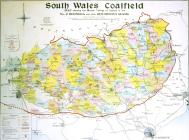1. Introduction: Glamorgan’s Blood: Dark Arteries, Old Veins
Items in this story:
Headgear with NCB flag, Nantgarw Colliery, 1952 (DNCB/14/4/87/70)
Glamorgan Archives received funding from the Wellcome Trust to catalogue the records of the coal industry in South Wales
Our ‘Glamorgan’s Blood’ exhibition was funded by Welsh Government through the Archives and Records Council Wales. It launched in October 2019 and was on display at Glamorgan Archives until the end of last year.
The exhibition was due to travel to venues across south Wales during 2020. We were only a few months into the tour when, as a result of the Covid-19 pandemic, we had to draw it to a close. The exhibition banners are now packed away until we can resume the tour.
In the meantime, we’ve added the exhibition content to our website so that it can be viewed and enjoyed from home.
The title of our project comes from Mervyn Peake’s poem, Rhondda Valley, which describes coal mining as the life blood of the valleys.
Here, are the stiffening hills, here, the rich cargo
Congealed in the Dark Arteries,
Old veins
That hold Glamorgan’s blood.
The midnight miner in the secret seams,
Limb, life, and bread.
Mervyn Peake, Rhondda Valley
By 1913 the south Wales coalfield was one of the largest coalfields in the world. In 1947 the industry was nationalised and the National Coal Board was created.
The rapid growth of the coal industry led to the development of a whole new society in south Wales, with a focus on the local colliery
South Wales Coalfield, c.1923 (DCOMC/29/6)
The coal collections at Glamorgan Archives document the development, change and decline of an industry synonymous with south Wales, charting its impact on the lives and health of miners and the wider coalfield community.
Caerau Colliery, 1952 (DNCB/14/4/24/5)


